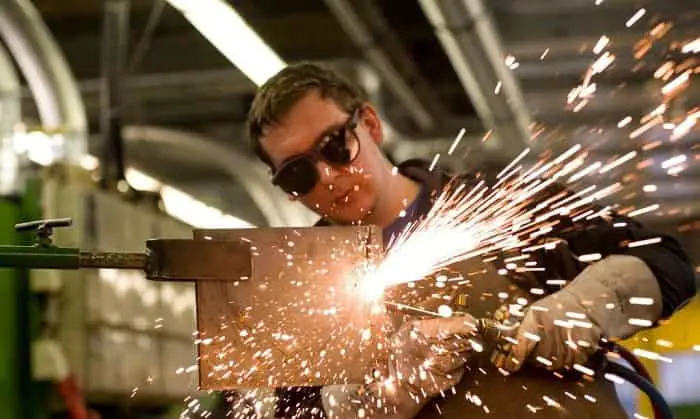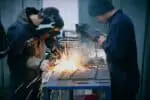Welding might be hazardous if you are not well protected. One of the pieces of equipment you’ll need is eye protection, but not just any regular glasses; you’ll need something that can minimise the risks of welding and keep your eyes protected.
It is never a good idea to wear sunglasses when welding since impact standards such as ANSI or CSA are not necessary for sunglasses and you might endanger your eyesight without sufficient protection.
Welding creates excessive heat and light, necessitating greater protection than simply eyewear. You must always wear a helmet in addition to safety eyewear.
Although your welding helmet provides enough protection, it is still not sufficient to protect your eyes from harmful UV light and sparks from welding. Therefore, it is advisable to wear safety glasses beneath the helmet.
So, why are sunglasses not fit to be used while welding?
This isn’t debatable because welding always necessitates the use of safety eyewear. Arc welding generates a lot of powerful electric arcs that wearing anything less than protective glasses would almost certainly cause eye injury or long term harm.
And there are reasons why sunglasses are unable to protect against intense light and hot projects caused by arc welding.
1. Sunglasses only offer some impact protection.
Impact standards such as ANSI or CSA are not necessary for sunglasses. This implies that, even though they are supposed to be impact resistant, there is no assurance that they will sustain the same kind of impacts as welding safety glasses.
2. Polarization simply blocks one kind of light.
While polarised sunglasses can shield you from horizontal light, there are other sorts of light you should avoid while welding.
Welding light goes in multiple directions- horizontally, vertically, and diagonally. Too much of this light would pass through and around sunglasses to make them a viable source of light shielding when welding.
3. The weld arc is simply too bright.
Even the greatest and darkest polarised sunglasses are insufficient for the intensity of a welding arc’s brightness.
When you look at welding glasses and shields, you’ll notice that they’re a lot darker than your ordinary pair of sunglasses because they come with varying shades that can be adjusted accordingly.
4. Welding generates additional hazardous pollutants besides just harmful UV light
A welding arc emits infrared and ultraviolet light in addition to visible light, which sunglasses cannot block.
While sunglasses may be able to protect against ordinary light, you are unlikely to find a pair that can also protect against infrared radiation.
When deciding on the sort of welding glasses to purchase, you must consider more than simply the amount of sunshine. In reality, sunlight should not be taken into account at all.
There are several factors to consider, including the type of light, the direction of the light, and the brightness of the welding arc.
Why should you go for proper welding glasses?
1.) Safety glasses can help protect your eyes from hazards like flying materials, sparks, and hot slag.
2.) Since your welding helmet alone cannot keep you safe, as an added layer of protection, helmet manufacturers recommend wearing a pair of authorised safety glasses inside your helmet.
3.) Welding while wearing an appropriate helmet but without wearing safety glasses increases the chance of flying debris colliding with your eyes and causing serious harm.
4.) Welding glasses keeps debris out of your eyes when your mask is on or if anything occurs to fly up under your mask.
5.) Welding glasses provide different shading levels according to the type of welding you’re doing. And sunglasses on the other hand do not provide shade options.
What makes welding glasses apt for welding work?
Here are a few reasons why welding glasses are required-
• Light absorption by UVA and UVB.
• Lenses made of high-impact polycarbonate.
• Anti-fog and anti-scratch coating
• Frame that wraps around.
• Lenses and frames of various colours.
• Lenses that reflect light
• ANSI/ISEA Z87.1 or CSA Z94.3 rating standards are met or exceeded.
Before you decide to purchase welding glasses, there are a few things you have to keep in mind.
• They must be able to shield the eyes from the front and sides in a safe manner.
• They must properly fit the user and be pleasant to wear.
• They must enable mobility while not obstructing the view.
• They must be long-lasting and smudge-free.
• They must not obstruct or interfere with the task.
Material of the lens
1.) Polycarbonate: Polycarbonate glasses are lightweight and UV-resistant.
2.) NXT Polyurethane (Trivex): Trivex is lightweight and highly visible, but it is pricey.
3.) Acrylic: Although acrylic is lighter than glass, more scratch-resistant, and less costly, it does not provide particularly clear vision and is not very durable.
4.) Optical glass: Glass does not distort what you’re looking at and can be scratched, but these glasses are hefty and do not stand up to direct impact well.
Shades of Welding Lenses
When it comes to welding glasses, the shade number is the single most important thing to consider. The shade number refers to the blackness of the lens and is directly related to the forms of welding that are possible.
Some welding procedures emit more intense light and necessitate the use of more advanced eye protection. Some are not as bright, so you may select a lighter hue to view the welding pool better.
What colors are safe for welding?
Brazing and soldering, on average, create less brightness and need a shade of 3 or 4, whereas stick welding requires a shade of 8 to 12.
MIG and TIG welding employ higher amperage and generate the brightest arc, therefore a shade of 8 to 13 is preferable, while carbon arc welding requires a shade of 14 or higher.
Here’s a nice reference chart to help you out.
| Type of Welding | Recommended shade |
| Torch soldering | 2 to 3 |
| Torch brazing | 3 to 4 |
| Plasma art cutting | 10 to 14 |
| Plasma arc welding | 6 to 14 |
| Air carbon arc cutting | 11 to 14 |
| Gas tungsten arc welding | 8 to 14 |
| Flux core arc welding | 7 to 14 |
| Oxygen cutting | 5 to 6 |
| Gas welding | 4 to 8 |
| Shielded metal arc welding | 7 to 14 |
See also: Can I Use Welding Glasses As Sunglasses?
According to OSHA
Employers are required to protect their employees against recognised eye and face dangers by providing suitable PPE.
Such equipment must meet the specifications outlined in ANSI Z87.1, an American National Standards Institute standard for eye and face protection equipment.
The ANSI Standard is used to certify safety eyewear for usage in the workplace.
ANSI Z87.1 specifies a number of tests that certification safety glasses must pass before they can be used in the workplace. This comprises impact and coverage testing, as well as splash, dust, and optical radiation protection.
Safety glasses will always be labelled with their ANSI Z87.1 compliance as well as their impact rating. Glasses that can sustain a higher amount of impact, for example, will be labelled Z87.1+. These ratings can assist you in selecting the best pair of glasses for your welding and fabrication operations.
Recommended safety glasses for welding
1. Pyramex Safety Glasses
- Gloves, Eyewear, Ear Protection, Masks & Clothing
- Country of manufacture: United States
- Manufacturer: Pyramex
- Saf
Prices pulled from the Amazon Product Advertising API on:
Product prices and availability are accurate as of the date/time indicated and are subject to change. Any price and availability information displayed on [relevant Amazon Site(s), as applicable] at the time of purchase will apply to the purchase of this product.
When you’re not wearing your higher shade glasses, they’re an excellent choice for cutting, light brazing, or utilising other power tools.
The glasses are fashionable and pleasant to wear and there is considerable gap around the frame to allow for air passage, ensuring optimum protection without boiling up.
The lenses are scratch-resistant and also ANSI high impact certified, so you’re getting a sturdy set of glasses that should last a long time.
2. Hobart Safety Glasses for Welding
- Mirrored shade 5 lenses
- Shatterproof polycarbonate
- Scratch resistant coating
- Meet ansi z87.1 standa
Prices pulled from the Amazon Product Advertising API on:
Product prices and availability are accurate as of the date/time indicated and are subject to change. Any price and availability information displayed on [relevant Amazon Site(s), as applicable] at the time of purchase will apply to the purchase of this product.
These safety glasses are apt for welding as they are scratch-resistant, shatterproof and provide maximum protection.
3. Miller Welding Safety Glasses
- Photochromatic Lens
- ArcArmor UV Protection: 99.9%
- Frame Design: Wraparound X-
Prices pulled from the Amazon Product Advertising API on:
Product prices and availability are accurate as of the date/time indicated and are subject to change. Any price and availability information displayed on [relevant Amazon Site(s), as applicable] at the time of purchase will apply to the purchase of this product.
These safety glasses have polycarbonate lenses in a wraparound frame. They are attractive, unisex, and universal in size. The best part is that they are quite inexpensive.
Conclusion
If there is one takeaway from this article is that sunglasses aren’t the best approach to protect your eyes when welding.
And to guarantee proper protection from the heat and voltage produced by welding, you should wear at least safety glasses along with a helmet.
Hope this article has given you enough reasons to not take your safety for granted while welding.










